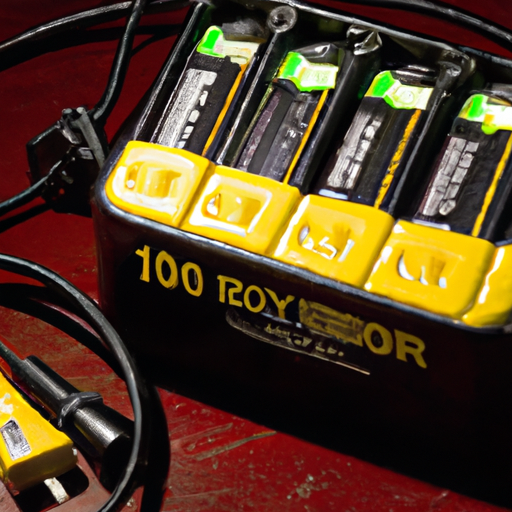Have you ever found yourself confused by the indicator lights on your Ryobi battery charger? Fear not! This article is here to shed some light on the subject (pun intended). We’ll break down each indicator light and explain what it means, simplifying the process of charging your Ryobi battery. Whether you’re a first-time user or a long-time DIYer, this article will provide you with the knowledge you need to confidently charge your batteries and power your tools. So, let’s get started and unlock the mysteries of the Ryobi Battery Charger Indicator Lights!
Overview of Ryobi Battery Charger
What is a battery charger?
A battery charger is a device used to recharge batteries, providing them with the necessary electrical energy to power devices. It is an essential tool for those who use battery-powered equipment and want to prolong the lifespan of their batteries.
Introduction to Ryobi battery charger
The Ryobi battery charger is a popular choice among DIY enthusiasts and professionals alike. Known for its reliability and efficiency, it is designed to be compatible with Ryobi’s line of power tools and batteries. The Ryobi battery charger offers a convenient and easy way to recharge your batteries, ensuring that they are always ready for use when you need them.
Importance of indicator lights
The indicator lights on the Ryobi battery charger are a crucial feature that provides valuable information about the charging process. These lights help users understand the status of their batteries, allowing them to make informed decisions and ensure optimal charging conditions. By understanding the indicator lights, you can maximize the performance and lifespan of your batteries, avoiding potential issues and ensuring their longevity.
Understanding the Indicator Lights
Types of indicator lights
The Ryobi battery charger features different types of indicator lights, each serving a specific purpose. These lights are designed to provide information about the charging process, ensuring that users can monitor the progress effectively. Some common types of indicator lights found on the Ryobi battery charger include power lights, charging lights, and fully charged lights.
Meaning of different colored lights
The indicator lights on the Ryobi battery charger are color-coded, with each color representing a specific status or condition. Understanding the meaning of these colors is essential to determine the charging process’s progress and identify any potential issues. For instance, a red light may indicate that the battery is charging, while a green light may indicate that the battery is fully charged and ready for use.
Flashing versus steady lights
The indicator lights on the Ryobi battery charger can either be flashing or steady, and the distinction between the two is crucial in understanding the charging process. A flashing light typically indicates that the battery is in the process of charging, while a steady light suggests that the battery is fully charged and ready to be used. By paying attention to these lights, you can ensure that your batteries are charged efficiently and avoid overcharging.
Charging Process and Indicator Lights
Initial connection
When you connect your battery to the Ryobi charger, the indicator lights will provide immediate feedback regarding the connection’s success. A power light may illuminate to indicate that the charger has a power supply, ensuring that the charging process can begin. The indication of a successful connection allows users to proceed confidently with the charging process, ensuring that their batteries are ready for use when needed.
Charging in progress
Once the battery is connected and the charging process is initiated, the indicator lights will provide ongoing updates on the battery’s status. A common indicator light for this stage is a flashing red light, which signifies that the battery is being charged. This continuous feedback reassures users that the charging process is underway, allowing them to plan accordingly and estimate when their battery will be fully charged.
Fully charged indication
When the battery reaches its full charge, the indicator lights on the Ryobi battery charger will inform you that the charging process is complete. This indication is typically represented by a steady green light, indicating that the battery is fully charged and ready for use. It is essential to remove the battery from the charger promptly to avoid overcharging and prolong the battery’s overall lifespan.
Common Issues with Indicator Lights
No indicator light
If you encounter a situation where there is no indicator light when you connect your battery to the charger, it may indicate a power issue. The first step would be to check if the charger is properly plugged into a functioning power outlet. If the power source is not the problem, there may be an issue with the charger itself. In such cases, contacting Ryobi customer support or referring to the user manual for troubleshooting steps is recommended.
Red light not turning off
If you notice that the red light on the Ryobi battery charger remains on even after an extended period, it may indicate a potential issue. This situation could suggest that the battery is not charging correctly or that there is a faulty connection. To troubleshoot this issue, you can try disconnecting and reconnecting the battery, ensuring a secure connection. If the problem persists, it may require further troubleshooting or consultation with Ryobi customer support.
Inconsistent light behavior
In some cases, you may encounter inconsistent or abnormal behavior from the indicator lights on the Ryobi battery charger. This may include lights flickering, flashing erratically, or not displaying the expected color. In such situations, it is advisable to review the user manual or contact Ryobi customer support for guidance. They will be able to provide specific instructions for troubleshooting and resolving any issues with the indicator lights.
Troubleshooting Guide
Check power source
If you encounter issues with the indicator lights or charging process, the first step is to ensure that your Ryobi battery charger is connected to a functioning power source. This involves checking the power outlet, making sure it is powered on and supplying electricity. If you are using an extension cord, verify that it is properly connected and functional. It is essential to rule out any power source issues before proceeding with further troubleshooting steps.
Inspect battery and charger
Another vital step in troubleshooting the Ryobi battery charger is to inspect both the battery and the charger for any visible signs of damage or wear. Check for any loose connections, damaged cables, or bent pins. If you notice any issues, such as a bent pin or frayed wire, it may be necessary to replace or repair the damaged component. Additionally, ensure that the battery is compatible with the charger and that it is properly inserted.
Resetting the charger
If you have checked the power source and inspected the battery and charger but are still experiencing issues, you can try resetting the charger. To do this, disconnect the charger from the power source and remove the battery. Leave the charger unplugged for a few minutes to allow it to reset. Afterward, reconnect the charger to the power source and reattach the battery. This simple reset may resolve any temporary issues and restore proper functioning to the Ryobi battery charger.
Safety Considerations
Proper handling of batteries
When using the Ryobi battery charger, it is essential to handle the batteries with care and follow proper safety protocols. Always wear appropriate safety gear, such as gloves and safety glasses, when handling batteries. Avoid dropping or damaging the batteries, as this can lead to leaks or malfunctions. Ensure that the batteries are clean and free from any debris before inserting them into the charger.
Avoiding electrical hazards
To ensure safety while using the Ryobi battery charger, it is crucial to avoid electrical hazards. This includes keeping the charger and batteries away from water or any other liquid that may cause electrical shorts or damage. Avoid using the charger in damp or wet environments, and never touch the charger or batteries with wet hands. Additionally, it is essential to keep the charger and batteries away from heat sources, flammable materials, and direct sunlight to prevent any potential accidents.
Tips for safe charging
To ensure safe charging with the Ryobi battery charger, there are a few additional tips to keep in mind. Always follow the manufacturer’s instructions and guidelines when using the charger. Avoid charging batteries in extreme temperatures, as this can affect their performance and lifespan. When connecting the battery to the charger, ensure a firm and secure connection. Finally, never leave batteries unattended while charging, and always disconnect them from the charger once the charging process is complete.
Tips for Maximizing Battery Performance
Choosing the right charger
To maximize battery performance, it is crucial to choose the right charger for your Ryobi batteries. Ensure that the charger is compatible with your battery’s voltage and chemistry. Using an incorrect charger can lead to suboptimal charging performance and potentially damage the battery. If in doubt, consult the user manual or contact Ryobi customer support for guidance on selecting the appropriate charger.
Proper storage
Proper storage is essential for maximizing battery performance and prolonging their overall lifespan. When not in use, store your Ryobi batteries in a cool, dry place, away from direct sunlight and extreme temperatures. Avoid storing them on concrete surfaces, as this can drain the batteries’ charge. It is also recommended to store the batteries in a protective case or bag to prevent any accidental damage or discharge.
Regular maintenance
Regular maintenance can go a long way in maximizing the performance and lifespan of your Ryobi batteries. This includes periodically cleaning the battery contacts with a dry cloth to remove any dirt or debris. It is also advisable to check for any signs of damage or wear, such as cracks or leaks, and address them promptly. Additionally, ensure that the batteries are charged and discharged regularly to maintain their optimal health.
Different Models and their Indicator Light Systems
Overview of popular Ryobi models
Ryobi offers a range of battery charger models, each with its features and functionalities. Some popular Ryobi models include the P118 charger, the P117 charger, and the P119 charger. Each model is designed to be compatible with different Ryobi battery types and offers specific indicator lights and charging capabilities.
Comparison of indicator light functionalities
While the indicator light functionalities may vary slightly between different Ryobi charger models, the basic principles remain the same. Most models feature similar indicator lights, including power lights, charging lights, and fully charged lights. These lights serve the same purpose across models, providing users with valuable information about the charging process and battery status.
Frequently Asked Questions
How long does it take to charge a Ryobi battery?
The charging time for a Ryobi battery can vary depending on several factors, including the battery’s capacity and the specific charger model. As a general guideline, it may take anywhere from 30 minutes to a few hours to fully charge a Ryobi battery. For more accurate information, it is recommended to refer to the specific charger and battery model’s user manual, as they often provide estimated charging times.
What should I do if the indicator lights are not working?
If the indicator lights on your Ryobi battery charger are not working, it may indicate a potential issue with the charger or the power source. Firstly, ensure that the power source is functional by checking the power outlet and the charger’s connection. If the power source is not the problem, try disconnecting and reconnecting the battery to reset the charger. If the issue persists, it may require further troubleshooting or contacting Ryobi customer support for assistance.
Are the indicator lights the same for all Ryobi battery chargers?
While the indicator lights on Ryobi battery chargers generally serve the same purpose across models, there may be slight variations. Some charger models may have additional indicator lights or different color-coding systems. To ensure accurate information regarding indicator lights, it is best to refer to the specific charger model’s user manual or consult Ryobi customer support.
Conclusion
Understanding the indicator lights on your Ryobi battery charger is crucial for efficient charging and maximizing battery performance. By familiarizing yourself with the types and meanings of the indicator lights, you can monitor and manage your battery’s charging process effectively. Additionally, following safety considerations, troubleshooting tips, and maintenance guidelines will ensure safe and optimal charging experiences. With the proper understanding of the Ryobi battery charger indicator lights, you can enhance the performance and prolong the lifespan of your batteries, enabling you to tackle your projects with confidence and ease.


